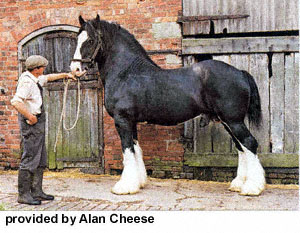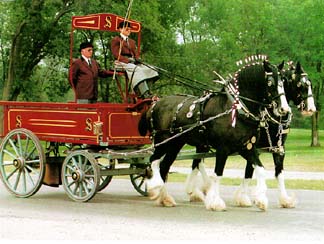

Shire


Introduction: If you have any comments or suggestions, please click here.
Names: Shire. Named for the Shires that bred them. (A county in England is called a "shire.")
Origin: In
1310 Edward II imported forty-two Lombardy horses, twelve of which had
"extraordinary strength." Crossed with native and imported stock, these horses
were the part ancestors of the Great Horse of England, which in turn helped
found the Shire.
Originally bred only in the shires. Today a few studs
remain mostly in the Eastern districts of England. (Shire Horse Society.)
Breeding: The
Shire was developed in England, no doubt with important contributions from the Norman
horse introduced by William the Conqueror in 1066.
In the 1880's Shires had a spurt of popularity in the United
States
with 400 imported in the year 1887 alone. Registrations
subsequently fell off sharply.
Today, perhaps the most powerful type of all heavy draught
horses. The breed is descended from the Great Horses of the Middle Ages,
from local mares, and from imported draught horses. (Shire-horse
Society of the United Kingdom of Great Britain and Ireland--founded 1878.)
Description: The Shire is almost as heavy as the Belgian, but longer-backed and less rotund.
Action: Good mover at the walk. Able to draw considerable loads. Energetic action in the trot.
Body: Beautifully carried, but not very long neck. Shoulders not too oblique, well placed. Great depth in the girth; barrel-shaped, well-sprung ribs. Powerful, short back.
Color: A summary of the colors might say that it is usually bay, black or brown with lots of white markings. The legs are usually white from knee or hock to hoof, and the face often has white markings. It is also sometimes gray. Commonest colours are bay, brown, black and grey.
Hair: Lots of feather. Long, thick, ample mane. Thickly covered tail set on and carried well. Feathers thick, plentiful, almost silky.
Head: Narrow. Big with broad forehead. Small, well-placed ears.
Hooves: Large and firm with sound soles.
Legs: Powerful, muscular forearms and thighs. Broad, strong joints; rather steep hindquarters; short, strong pasterns.
Size: This largest draft breed weighs a ton or more. There is some disagreement as to the height: Anything from averaging 17 hands, to up to 18 hands, to 17 hands and taller! The tallest documented horse was a Shire gelding called Sampson; foaled in 1846, he measured 21.2 hands in 1850 and weighed 3,360 pounds. Height between 17.1 and 18 hands.
Temperament: Docile. Good-natured character and placid temperament.
Features: Hard worker. Very large, powerful, heavy draught horse of enormous strength.
Uses: Once carried knights in armor.
Later, its uses were mainly
agricultural. It was used extensively for haulage and farm work until replaced
by mechanization. Yet even today, some farmers find horses and tractors
complementary, and one 1968 horse show had the highest Shire entry for fifteen
years.
Breweries gain prestige from their heavy horse teams, and it has
been established that horse delivery, up to ten miles, costs four shillings per
barrel less than by truck. One brewery keeps twenty-eight Shires in the
City of London and since 1954 has supplied six grays each year to draw the 4
1/2-ton Lord Mayor's coach for his procession.
Accomplishments:
Curiosities: Two Shires once
moved an 18 1/2-ton load over a slippery surface, with the shaft horse under way
before its leader was pulling!
Edward II's Archbishop lamented the cost of his forty-two heavy horses at three shillings per head, per week,
"enough to keep four or
five poor people!" Included in the Shire's daily working ration is
15 pounds of bruised oats and 25 pounds of chaffed hay.
Profiles:
Conclusion: